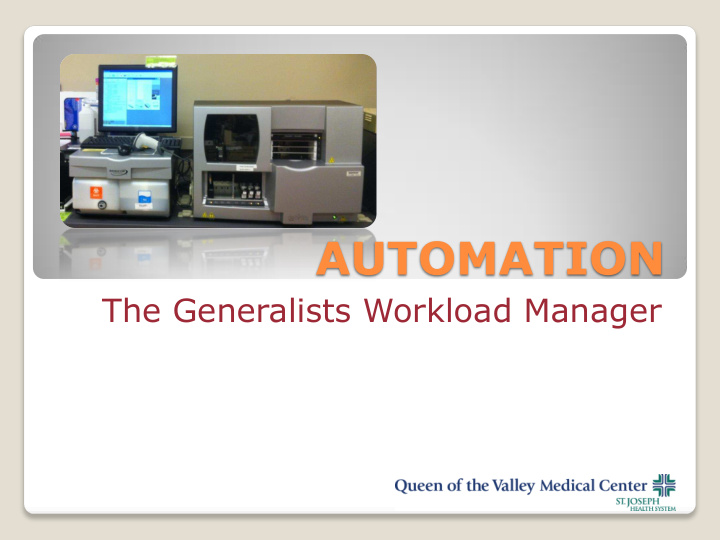



AUTOMATION The Generalists Workload Manager
IMMUCOR USER GROUP MEETING 2016 C Michelle Roye MS(CLM), CLS, ASCP(MLS)
Discuss the challenges and potential inefficiencies of a smaller transfusion service Describe the importance of audits and how they can help a smaller transfusion service overcome these inefficiencies List different startegies to overcome these challenges Objectives
Four St. Joseph hospitals in Northern California. Redwood Memorial Hospital Petaluma Valley Hospital Santa Rosa Memorial Queen of the Valley Medical Center Queen of the Valley Medical Center was founded in 1958 by the Sisters of St. Joseph of Orange. A Catholic non-profit, full-service diagnostic and therapeutic medical facility. About Us
Queen of the Valley Medical Center is dedicated to the Napa Valley community, bringing Commitment to the Napa Valley Trauma Center ◦ Upcoming Urgent Care Center Cardiac Center Oncology Services Labor and Delivery Therapy Center Fitness Center About Us
Transfusion Service Move-In Date November 16, 2014 Queen of the Valley Medical Center Herman Pavilion
Patient Census Increasing census 208 bed hospital with a fluctuating census daily average of ~87 patients (and growing) Includes 36 ICU beds Move to Herman Pavilion
Small Community Staffing Restraints The Generalist ◦ Cross-Cover Competencies/Training Fluctuating Census Challenges
Strategies Focus on Department Efficiency What needs to change to become a more efficient department? Evaluate efficiency within new Transfusion Service both automated and manual. Evaluate processes and test workload functions for the change in environment and staffing. Different Approach
Focus Operational Audit Determine ECHO Test Use 1. post-Laboratory Move Evaluate Bench Time and Test Performed 2. Improvements Opportunities 3. Improvement Plan/Steps 4. Purpose of Audit
In-Line with Hematology Pneumatic Tube System around corner Easy Specimen Receipt Easy Processing ECHO PLACEMENT
Current Tests Type and Screens Weak D testing DAT’s ABID ◦ Ready ID ◦ Extend I/II Testing Performed on ECHO
In the Numbers….. Tests 15-Mar 16-Jan ECHO ave daily tests 11 11 ECHO total tests 311 302 Manual Methods Cord 23 41 ABORh 5 33 DAT 22 30 ADC (average daily census) 87.5 91.3 DATA
Decrease in Tests performed on ECHO & Increase of Manual Tests Performed. DAT's 30 20 10 0 March January DAT Manual DAT ECHO AUDIT: Test Volume Comparisons
Bench Hours Hours Mar-15 Jan-16 Total Hours ABORh 0.25 1.7 1.95 DAT 3.7 5 8.7 Cord Screen 3.8 6.8 10.6 21.25 Total 21.25 Hours Could CLS be performing other tasks? Tech Hours
Of the 21¼ hours used on the manual tests, ~50% of those tests were hours used to perform cord screens. Total Hours 9% 50% ABORh 41% DAT cord Opportunity
Cord Blood Screens Validate Cords on ECHO Allow cross-cover generalist to attend to other departmental needs. ABORh Encourage Staff to use ECHO Test is less than 10 minutes. Can batch multiple blood types, if applicable. Opportunity
Cord Screen ◦ Validate on ECHO ABORh ◦ Train staff DAT ◦ Evaluate SOP ◦ Redundancies Re-Evaluate Process Improvement Plan
CORD VALIDATION Presented Data to Pathologist Contacted Immucor ◦ Updates? ◦ Programming? ◦ Validation Forms? ◦ Suggestions? Validation New Procedure STEPS
ABORH Educate/Encourage staff as to Advantage Email Staff ◦ Outcome of Audit ◦ Time Use STEPS
DAT Procedural (Test Duplicated) ◦ Review for redundancies ◦ Update ◦ Retrain STEPS
Cord Screen Set up ECHO for “Pediatric” test Washing specimens ◦ May cause false negatives K2 EDTA Cord specimen ◦ Most of the specimens test good ◦ Did generate error due to clots 12x75 Test Tubes ◦ Advised by Immucor ◦ Transfer from EDTA ◦ All specimens ran with no errors. Preparation time Validation
New/Updated Procedures Training Oral Assessments Written Assessments Direct Observations Questions Sign-Offs Training
6 Months Rerun ECHO Statistics Re-assess Manual Tests Performed Review Data for changes in Manual Test Review Data for changes in Manual Hours *Best to run data on same months previously evaluated Re-evaluate
QUESTIONS?
Recommend
More recommend